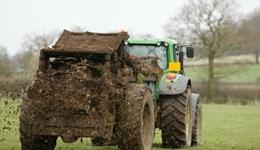The more you add, the more you get
Many soils are suffering from a lack of organic matter. Aim to increase your soil organic matter levels, as this can have multiple benefits for soil health.
The simple rule is, add more organic materials, build more soil organic matter.
The levels of organic matter in any soil are a result of the equilibrium between the inputs of organic matter and the decomposition of the organic matter by soil organisms.
The disruption of soil aggregates during tillage changes the distribution and accessibility of organic matter in soil and usually increase rates of decomposition.
Inputs
Inputs vary through the year as crops grow and the amount and activity of roots change.
Return of crop residues also increases inputs of organic matter to soil; this occurs with improved crop yields or the introduction of cover crops to a rotation.
Inputs might also be added from outside the field/farm in manures, composts and biosolids.
Before using any organic materials, first check for compliance with your crop assurance scheme.
Impacts of adding organic matter
Where soils are compacted, they can be improved by increasing organic matter content.
This can be done over several years by applying bulky organic materials such as green compost or farmyard manure. Alternatively, it can be done over a longer period by using cover crops, green manures, and grass leys.
If there are clear signs of compaction (e.g. a well-developed tillage pan), appropriate cultivations will be necessary before the plants can do their work, i.e. a combination of ‘metal’ and roots.
Although increases in soil organic matter are positively related to the amount of organic matter added, not all organic matter inputs have the same impacts.
Composts typically have a higher lignin content – which is more resistant to microbial breakdown – than farmyard manures, and therefore tend to increase organic matter content more quickly (relative to the same amount of organic matter added).
Farmyard manures usually contain more fresh organic matter and are better at stimulating biological activity and increasing microbial biomass.
Table 1. Typical range of impacts seen for different inputs of organic materials imported to the field/farm
| Organic material | Examples | Impacts on | |||
|---|---|---|---|---|---|
| Soil biology | Soil structure* | Readily available nitrogen | Other nutrients | ||
| Solid: ‘stable’ | Compost | Moderate improvement | Moderate improvement | Low | Many materials supply important quantities of phosphorus and other nutrients.
See the AHDB Nutrient management guide (RB209) for details. |
| Biosolids | Some improvement | Moderate improvement | |||
| Solid: ‘active’ | FYM | Large improvement | Large improvement | ||
| Poultry manures | Moderate improvement | Little or no improvement | High, nitrogen loss by volatilisation or leaching likely | ||
| Liquid | Slurries and digestates | Little or no improvement | Little or no improvement | High, nitrogen loss by volatilisation or leaching likely |
* The impacts on soil structure summarised here assume it is possible to make a timely application of the bulky organic materials, so no compaction results from the application process itself
Loading rate
The actual impacts of organic materials depend on loading rate (rate and frequency of application).
The amount of organic material applied to soil is usually given in t/ha but be careful to take account of whether this is the total amount or a dry weight.
Organic materials can range widely in their water content from only 10–90%. The amount of carbon applied is closely related to the total dry matter application; each tonne of dry matter contains about 580 kg of carbon.
Remember to allow for the nutrient content of organic manures.
An application of green compost supplying 250 kg/ha total nitrogen (N) will add about 4.5 t/ha of organic matter.
Table 2. Organic materials are a good source of organic matter
| Organic material | Dry matter | Application rate (t/ha)* | Organic matter applied (t/ha) |
|---|---|---|---|
| Cattle FYM | 25% | 42 | 5.5 |
| Broiler litter | 60% | 8 | 2.5 |
| Green compost | 60% | 33 | 4.5 |
| Green/Food compost | 60% | 22 | 5.0 |
* using typical nitrogen content values, the application rates are within the Nitrate Vulnerable Zone (NVZ) organic manures field limit of 250kg total N per ha in any twelve-month period
Improvements take time
Increasing the total organic matter content in soils is difficult. Changes occur slowly and may be difficult to detect, except with repeated analysis over the long-term (5–10 years).
It can take several years of repeated management for changes to occur, particularly soil structural improvements.
Spring benefits
Improvement in productivity in arable systems after improved organic matter management takes some time to appear.
Spring crops have been shown to have the highest direct yield benefits from improved organic matter management, especially in years with extreme weather. This is likely to result from better establishment and more rapid rooting.
Consider the nutrient value
Given that applying bulky organic material has a financial cost, it is important to understand the merits of different organic materials.
First, consider the nutrient value of any imported materials. Once these have been taken into account, it is rarely economical to spend more than a further £30 per tonne (dry matter) of organic materials added to soil per hectare (including the costs of material, haulage and spreading).
Useful links
Read about the DC-Agri project, evaluating the effects of different soil-applied organic materials
Find out how the Farming Rules for Water impact on autumn applications of organic manures
Read the Principles of soil management guide
If you would like to order a hard copy of Principles of soil management, please use our online order form or call 0247 799 0069.



